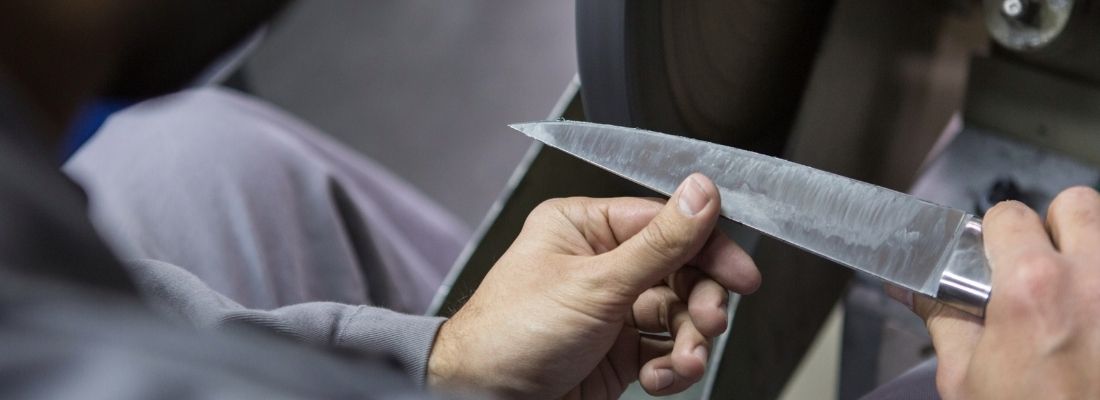
Did you know that the life of your handcrafted knife has begun a long time before it ended up on your table?
Making a knife is a long process, which requires patience, meticulousness and savoir-faire. Discover how our craftspeople turn simple wooden or steel pieces into knives with comfortable handles and sharpened blade. Making a knife shall no longer have any secret for you!
Before explaining you how knives are made, let’s talk about vocabulary!
To understand each stage of the manufacturing process of a knife, it is essential to know its anatomy.
A knife has a metallic part and a handle. The metallic part is composed of the blade, and in line with it, the tang. The tang is basically the metal part inside the handle. It allows the blade to be solidly fixed to the handle, generally with the help of rivets.
The blade of the knife is itself made of several parts. The grind is the part which gets progressively thinner at the bottom of the blade, which is called the sharp edge. The sharp edge/grind assembly makes the knife sharp. Now that you know its anatomy, you are ready to discover how to make a knife.
Manufacturing the blade of a knife: blacksmithing
The first step in making a knife consists, of course, in drawing it. The cutler adapts the shape of the blade to the use of the knife. A chef knife does not have the same blade as a sole fillet knife or a table knife.
Once the template has been drawn, blacksmithing begins. To make the blade of a knife, craftspeople generally work with steel. Blacksmithing consists in using a forge to make the temperature of the steel rise (around 900°), so as to make it malleable. It is then beaten with a hammer, using an anvil as support. The blacksmith then gives the blade its shape, by alternately putting it into the fire and beating it with the hammer.
Depending on the desired type of blade, the work can get more complex. For Damascus blades for example, several steel thicknesses are welded and superposed before being forged.
Making the blade of a knife: cutting
To make a handcrafted knife, cutlers copy its template onto the blade they have forged. They can then move on to the cutting stage. Using different tools, such as an angle grinder and a sander, they give the blade its shape.
Making a knife implies being able to fix the handle to the tang. To do so, the cutler drills holes in the tang. These are the places where the rivets shall be.
The cutler then makes the grind. This is a very technical gesture, which consists in sanding the blade to sharpen it progressively from bottom to top, while keeping the whole thing perfectly symmetrical.
Making a knife: thermic treatments
Making a knife requires several thermic treatments for the blade. First, there is the normalization stage. This consists in heating the blade in the forge to make it less fragile. Thanks to this, the blade shall not warp during the next stage: quenching.
Quenching or soaking is the action of plunging the blade in oil or water, right after heating it. By cooling very quickly, the blade solidifies. However, this also makes it breakable. One last thermic treatment is therefore necessary to make it flexible again: tempering.
Tempering simply consists in baking the blade in a home oven, around 200°C, for one or two hours.
Making a knife
Once the blade is ready, the handle can be made. The materials available are countless and the choice is both aesthetic and practical. For example, a stainless-steel handle is interesting since it can resist water, and can therefore be put in the dishwasher. However, it is less easy to handle since it tends to slip from your hands.
The materials which are commonly used to make a handcrafted knife are stainless steel, wood, bone, horns, antlers, leather, rubber, titanium, carbon fibre, fiberglass, aluminium, resin or POM.
Once the material has been chosen, cutlers cut two slabs and fix them to each side of the tang with rivets. The handle is then worked using a sander to obtain optimal grip.
Making a knife: finishing
The finishing stage for a knife consists in sharpening the blade, tinting the wood, and adding a stamp or an engraving.
Now that you know how to make a knife, you shall have a beautiful story to tell your guests when they ask you where your beautiful knives come from!







